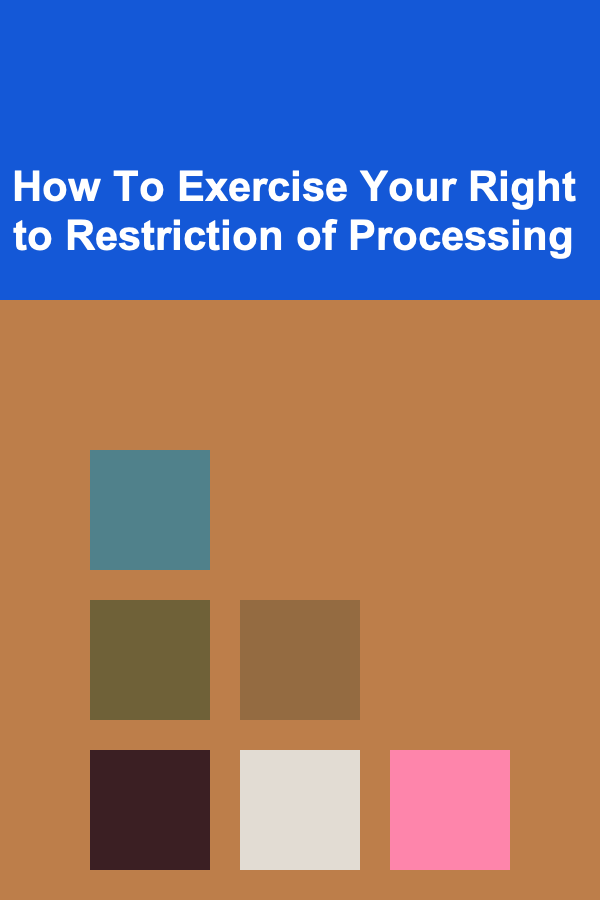
How To Exercise Your Right to Restriction of Processing
ebook include PDF & Audio bundle (Micro Guide)
$12.99$8.99
Limited Time Offer! Order within the next:

In today's digital age, the protection of personal data has become a major concern for individuals across the globe. With the growing reliance on online services, social media platforms, e-commerce websites, and various data-driven applications, individuals' personal data is continuously being collected, processed, and stored. As a result, privacy laws and regulations have been put in place to safeguard individuals' personal information.
One of the key rights afforded to individuals under privacy laws, particularly under the General Data Protection Regulation (GDPR) in Europe, is the "Right to Restriction of Processing." This right allows individuals to limit how their personal data is processed in certain circumstances. But how exactly can one exercise this right? What steps should individuals take to restrict the processing of their data, and why is it so important?
This article will explore the concept of the right to restriction of processing, the conditions under which this right can be exercised, and the steps individuals can take to ensure their data is processed in compliance with their preferences.
What is the Right to Restriction of Processing?
Under the General Data Protection Regulation (GDPR) and similar privacy laws around the world, the right to restriction of processing allows individuals to request that the processing of their personal data be limited or temporarily halted under certain conditions. This right is significant because it allows individuals to have more control over their data, particularly when they believe the data is being processed unlawfully or incorrectly.
The restriction of processing means that the data controller (the entity responsible for processing the data) can no longer use the data for its intended purposes or process it in any other way. However, the data controller may still store the data, but it cannot be used for further processing unless certain conditions are met.
Why is the Right to Restriction of Processing Important?
The right to restriction of processing serves several important purposes, including:
- Ensuring Accuracy: If an individual believes that their personal data is inaccurate or incomplete, they can request the restriction of processing until the accuracy of the data is verified.
- Protecting Privacy: When an individual feels that their data is being processed unlawfully, or without consent, this right allows them to limit the use of their personal data until the legality of the processing is resolved.
- Ensuring Fairness: This right can be exercised in situations where individuals dispute the legitimacy of the data controller's actions, such as where the processing does not align with the legal grounds stipulated in data protection laws.
- Managing Data Breaches: If a data subject suspects that a data breach has occurred, they can exercise their right to restrict processing while the matter is being investigated.
When Can You Exercise the Right to Restriction of Processing?
The GDPR provides individuals with the right to restrict the processing of their personal data in specific circumstances. It is important to note that this right is not automatic and must be exercised in accordance with specific legal conditions. These conditions include:
1. When the Accuracy of the Data is in Dispute
If you believe that your personal data is inaccurate, you have the right to request a restriction on processing while the accuracy of the data is being verified. For example, if a company holds incorrect contact details or financial information about you, you can request that they stop using this data until they can confirm its accuracy.
2. When the Processing is Unlawful
If you believe that your personal data has been processed unlawfully or without your consent, you have the right to request that processing be restricted. This can happen if a company has violated privacy laws by collecting or using your data without proper authorization or a legitimate basis.
In this case, restricting the processing of your data prevents the company from continuing to process it while the legality of the processing is under review.
3. When the Data is No Longer Needed
If a data controller no longer needs to process your data for the original purposes for which it was collected, you can request the restriction of processing. However, you may still allow them to store the data for a specific purpose, such as legal compliance or fulfilling a contract.
4. When You Object to Processing Based on Legitimate Interests
If a data controller is processing your data based on their legitimate interests, you have the right to object to the processing. If you raise an objection, the company must stop processing your data unless they can demonstrate that their reasons for processing outweigh your interests, rights, and freedoms.
During this time of objection, you can request that the processing be restricted until the company's legitimate interest in using your data is thoroughly evaluated.
5. When You Are in the Process of Exercising Your Right to Erasure
If you have asked for your personal data to be erased and the company is still considering your request, you may want to restrict the processing of your data in the meantime. During this period, the data controller can't process your data for purposes unrelated to the erasure process.
6. During the Period of Verification of Your Objection
If you object to processing under the basis of "processing for direct marketing," the data controller must immediately cease processing. However, if the data controller seeks to verify the legitimate grounds for processing, they must restrict the processing until they resolve the dispute.
How to Exercise Your Right to Restriction of Processing?
Exercising your right to restriction of processing requires taking specific actions and understanding the legal framework surrounding your data rights. Here's a step-by-step guide on how to exercise this right.
1. Identify the Data Controller
The first step in exercising your right to restriction of processing is to identify the data controller responsible for your personal data. The data controller is the organization, business, or entity that determines the purposes and means of processing your personal data.
This information is typically available in the organization's privacy policy or data protection statement, which should clearly explain how your data is collected and used. If you're unsure, you can contact the company's customer service or data protection officer for clarification.
2. Understand the Grounds for Restriction
To exercise the right to restrict processing, you must have a valid reason based on one of the conditions listed above. Ensure you have a clear understanding of why you are requesting the restriction and how it aligns with the GDPR or relevant privacy laws.
For example, if you believe your data is inaccurate, you can state that the processing should be restricted while the company verifies the data's accuracy. If the processing is unlawful, explain why you believe the data should no longer be used.
3. Submit a Request in Writing
Once you've determined that you have valid grounds for restriction, you should submit a formal request in writing to the data controller. This request should include:
- Your personal details (e.g., name, contact information)
- A clear statement requesting the restriction of processing
- The reason for your request (e.g., inaccurate data, unlawful processing)
- Any relevant supporting information or documents
Be specific and concise in your request. You may choose to send it by email, post, or any other method outlined in the company's privacy policy.
4. Await a Response
The data controller must respond to your request within one month. If the data controller agrees to restrict processing, they must inform you of the action taken and the duration of the restriction. However, if the request is refused, the data controller must provide you with a detailed explanation of why they have declined to restrict processing.
If they do not respond within one month, you have the right to escalate the matter by contacting a supervisory authority or seeking legal advice.
5. Follow Up if Necessary
If the data controller does not act on your request or provides an unsatisfactory response, you can follow up by reminding them of their obligations under data protection laws. Additionally, you can file a complaint with the relevant supervisory authority or take legal action.
How Does Restriction of Processing Impact Data Controllers?
For data controllers, the restriction of processing represents a significant step in their responsibilities to comply with privacy laws. When data processing is restricted, the organization is still allowed to store the data but cannot continue to process it for the purposes that were originally intended.
This can have operational consequences, particularly if the restricted data is integral to the company's business operations. However, the restriction must be respected, and data controllers must be prepared to either correct the data, justify its continued processing, or delete the data entirely.
Conclusion
The right to restriction of processing is a critical aspect of data privacy laws, empowering individuals to have more control over how their personal data is handled. Whether you're concerned about inaccurate data, unlawful processing, or the need to limit the use of your data for other reasons, exercising this right allows you to protect your personal information and ensure it is processed lawfully.
Understanding how to exercise this right is essential, as it ensures that individuals are not subject to unnecessary or unlawful processing of their personal data. By following the necessary steps to make a request for restriction, individuals can safeguard their privacy and hold data controllers accountable for their actions.

Empowering Patient Care: Strategies and Case Studies for Nurse Practitioners in Various Specialties
Read More
How to Build a Checklist for Onboarding New Employees
Read More
How to Create a Themed Party That Will Wow Your Guests
Read More
How to Decorate Your Home for a Romantic Date Night Party
Read More
How to Use Online Research Skills to Make Money
Read More
Choosing the Right Spark Plug Socket for Engine Tune-Ups
Read MoreOther Products

Empowering Patient Care: Strategies and Case Studies for Nurse Practitioners in Various Specialties
Read More
How to Build a Checklist for Onboarding New Employees
Read More
How to Create a Themed Party That Will Wow Your Guests
Read More
How to Decorate Your Home for a Romantic Date Night Party
Read More
How to Use Online Research Skills to Make Money
Read More